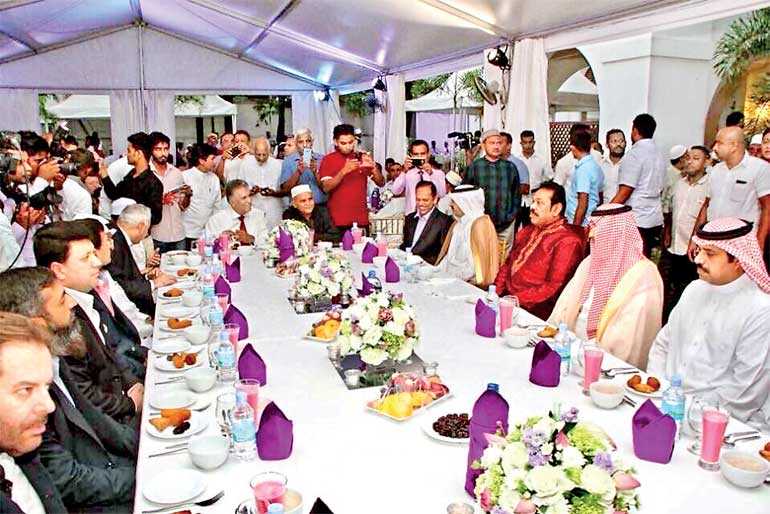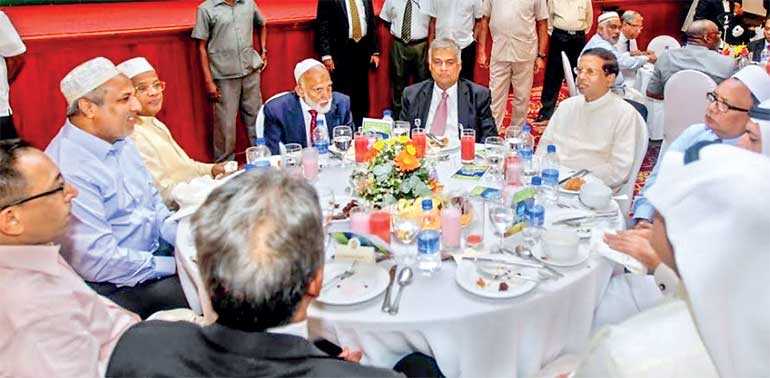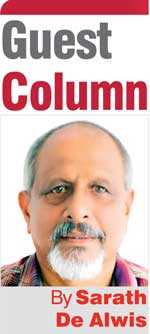Thursday Feb 27, 2025
Thursday Feb 27, 2025
Monday, 27 May 2019 00:00 - - {{hitsCtrl.values.hits}}


This essay is an excavation of the roots of mindless rage that burst out of the town of Kattankudy in the Eastern Province. It holds a truth that needs to be told.

In his short story ‘Appointment in Samara’, Somerset Maugham retells a 9th Century Arabic tale. It has a spectral resonance with the carnage we witnessed on Easter Sunday.
Once in Baghdad, a servant sent to the market to buy provisions by his master, a merchant, saw ‘death’ jostling at him. He returns to the master in a hurry trembling. He asks for a horse to ride away from the city to Samara where death would not find him.
As the servant rides away, the merchant goes to the market and asks ‘death’ why he made a threating gesture to his servant. Death replies innocently that he made no threatening gesture. He was surprised to see him in Baghdad, for he had an appointment with him that night in Samara.
The purpose of this essay is to understand how ISIS located the town of Kattankudy or conversely how Kattankudy linked up with ISIS.
Our first task is to understand what ISIS is. When we understand that, we can reasonably hope to learn how this small town in the Eastern Province became the fertile ground for such rapacious religious zealotry.
Salafi Jihadism is the ideology that propels the ISIS, Al-Qaeda and all other violent Islamic terror outfits.
Shiraz Maher, who teaches War Studies at King’s College London, published a groundbreaking study of ISIS in 2017 titled ‘Salafi- Jihadism – History of an Idea’.
He provides the authentic definition of Salafism given by the ‘Permanent Committee of Scholarly Research and Fatwas’ – Saudi Arabia’s highest clerical authority.
“Salafism is a philosophical outlook which seeks to revive the practices of the first three generations of Islam who are collectively known as ‘al-salaf al-ãlih’ – the righteous predecessors, the last of whom died around year 810.
These three generations together constitute what the Saudi clerics consider to be the Golden Age of Authenticated Orthodox Islam.
Salafism is a warped philosophy that believes in progression through regression.
The trend among radicalised Muslims is to see Muslim history as quintessentially that of a faith battling over centuries to preserve its purity.
They ignore the flowering of science, mathematics, and literature that was made possible by Muslim intellectuals from the eighth to the thirteenth century.
What ‘Salafism’ does is simple. It freezes history at a point that the orthodox Wahabism finds convenient. They are contemptuous of the Abbasid caliphate that made Baghdad, the home of universal wisdom where Plato the Philosopher from Greece and Aryabhata the Astronomer from India were translated to Arabic.
Salafism has made the young educated generation of Muslims take pride in the so-called purity of Salafist teachings rather than celebrating the diversity and richness of Arab history, Moghul history and Ottoman history. These educated young Muslims who will master digital technology would not know of Haroun Al Rashid of the Abbasid Caliphate, of Suleiman the magnificent of the Ottoman caliphate or Akbar the great of the Moghul dynasty.
When the Islamic Hijri calendar reached its first millennium in 1591 the great Mogul emperor Akbar ascended the throne of the vast land mass of India. He had the mind-boggling task of ruling over a diversity of Hindus, Muslims, Jains, Buddhists, Sikhs, Parsees Jews and many more.
Akbar found sanity in this confusion. Amartya Sen Economist, Philosopher and Nobel laureate describes the governance style of Akbar with a magnificent epigram.
It was ‘pursuit of reason rather than reliance on tradition’ – the only rational means of addressing knotty social problems.
Lone wolf terror
In his celebrated paper ‘Roots of Muslim Rage’, Bernard Lewis reminds us of Islam’s contribution to global order.
“Islam has brought comfort and peace of mind to countless millions of men and women. It has given dignity and meaning to drab and impoverished lives. It has taught people of different races to live in brotherhood and people of different creeds to live side by side in reasonable tolerance.”
He then ends his glowing tribute with an abrupt and laconic declaration.
“Islam is also known to have inspired in some of its followers horrible moods of hatred and violence. Salafi Jihadism has quietly taken root in Sri Lanka since the 1980s. This violent belief system is unsentimental and indifferent to tradition or history except where it concerns ritual authenticity.
What is of interest to us in Sri Lanka grappling to find a meaning in the madness of Easter Sunday is the so called ‘lone wolf terrorism’. The author of ‘Salafi Jihadism – History of an Idea’ says that the lone wolf idea was theorised by Abu Musab al-Suri of the central leadership of al-Qaeda.
Lone wolves are typically those individuals who have no direct contact with the fountains of terror located in the deserts of Arabia or the mountains of Afghanistan and Pakistan. They are not connected to any discernible network.
Nonetheless, they are sufficiently inspired by the cause and are ready to act in its name.
Their connection to the movement comes from proximity to and empathy with the world view of Salafi Jihadist Terrorism. That brings us to the pivotal issue of Kattankudy.
How did ‘Kattankudy’ reach proximity with Salafi Jihadist terror? How did this quaint little town develop an empathy with an ‘ummah’ committed to the ultimate Armageddon?
‘Religious identity politics’
In comparison to other communities, the Muslims of Sri Lanka resisted missionary proselytisation. This made the community largely immune to the process of colonial modernisation. Since independence, Muslim politics remained the hegemonic preserve of an elite Muslim merchant class.
In the post-independence era, this elite Muslim leadership willingly colluded with Sinhala majoritarian nationalism.
In exchange for their political allegiance, they received concessions and accommodation in the pursuit of their commercial activity and the facilities for fostering their cultural identity.
This idyllic narrative is recalled with antiquarian melancholy by Lorna Devaraja in her ‘Muslims of Sri Lanka – 1000 years of ethnic harmony’.
This cosy arrangement was turned on its head when the 13th Amendment introduced the Provincial Councils under the 1978 Constitution that replaced the first past the post system of elections with proportional representation.
On 11 September 1981, Muslims politics of Sri Lanka changed course drastically and unalterably in the quiet quaint Qur’anic town of Kattankudy.
A small group of Muslim leaders of the Eastern Province met in this small town to form the Sri Lanka Muslim Congress and to elect ‘Marhoom’ M. H. M. Ashraff as its Founder-President.
From that point onwards, Muslim identity politics took centre stage. Muslims of Sri Lanka assumed the dubious distinction of being the only ethnic group whose identity was solely based on religion. Lorna Devaraja’s narrative of 1000 years of ethnic harmony was unceremoniously jettisoned. Assertive identity politics replaced assimilative politics.
Despite the low-key start in 1981, the party made quiet progress. In island-wide Pradeshiya Sabah Elections in 1987, it won 29 seats. The decisive point of departure was when the SLMC captured 17 seats in the merged North Eastern Provincial Council.
The new party was now ready to leverage its political clout. Under the then prevailing electoral law of proportional representation, the cut-off point in Parliamentary elections was one-eighth, or 12.5%, of the total polled. The SLMC, taking note of its performance in the Provincial Council elections of 1988 wanted the cut-off point lowered.
The new party cannily declared its support for Sirimavo Bandaranayake in the impending Presidential election. It hit bull’s-eye.
The other aspirant R. Premadasa not only sat up but in effect looked up to Ashraf as man to do business with. Premadasa accurately apprehended what Ashraf was after.
The 15th Amendment that eliminated electoral zones and reduced the cut-off point to 5% was passed on 8 December 1988 by a Parliament that stood dissolved effective 20 December 1988 – one day after the Presidential election.
A smug SLMC switched support to Prime Minister Premadasa.
The Sri Lanka Muslim Congress demonstrated that it could leverage its electoral punch even before it had a single elected member in Parliament. The rest is history.
The SLMC and its multiple splinter groups have held Ministerial office in all subsequent governments.
The ethno-religious identity of Muslims of Sri Lanka became not just a dominant factor. In our ferociously competitive politics of expediency, it became the single arbitrating factor.
Successive governments oblivious to the threat, created a vast comfort zone for Salafist Jihadist ideology to spread through the length and breadth of the Muslim community of Sri Lanka. Kattankudy became the central citadel of the pervasive doctrine of Salafist Jihadism.
In the 38 years of its existence the SLMC and all its breakaway subgroups have excelled in parochial patronage politics. This is in sharp contrast to the right’s centric politics of the major Tamil minority politicians. They never abandoned what Max Weber called ‘ethics of conviction ‘and ‘ethics of responsibility’, (German – Verantwortungsethik).
The SLMC and splinters supported the 18th Amendment that emasculated the independent commissions. They supported the impeachment of a Chief Justice. Access to State resources to coddle their core constituency was the sole raison d'être that determined their politics. They are the quintessential ‘true believers’ in progression through regression. They are the true believers of progression through regression.
SLMC’s ethno-religious identity politics politicised the Muslim community in a virulently organic methodology.
This time last year, Muslim communities were competing to hold ‘Iftar’ celebrations with the Rajapaksa brothers in attendance. Of the three siblings, Gotabhaya received top billings.
A video of Gotabhaya Rajapaksa being ushered to a grand ‘Iftar’ ceremony by white-robed ‘mullahs’ chanting panegyric Arabic poetry went viral last year.
Religious identity politics of SLMC and its many offshoots and subgroups had both major political camps turning a blind eye to the creeping threat of Salafism and Salafist Jihadism.
We must recognise some basic truths. For the Muslim, the religion is not only universal but is also central to their being. The faith of Islam is the essential basis of identity and loyalty.
Muslims pray five times a day. We non-Muslims do not understand the dominant and central role of Islam in the life of a Muslim. So, we will never understand how an entire civilisation can have their religion as the primary basis of loyalty.
The SLMC and other Muslim parties were united in their resolve to create a cultural comfort zone for the Muslims. In this conducive climate, some good pious people of Kattankudy were seduced by Salafist Jihadism that taught the faithful how to reach heaven by ‘other means’!
The parable ‘Appointment in Samara’ holds a lesson for those now eager after the blood bath of Easter Sunday to arrest an idea somehow while not quite certain as to what awaits us.
When we create the conditions, we must also be willing to come to terms with the inevitable that follows our myopic actions.
Discover Kapruka, the leading online shopping platform in Sri Lanka, where you can conveniently send Gifts and Flowers to your loved ones for any event including Valentine ’s Day. Explore a wide range of popular Shopping Categories on Kapruka, including Toys, Groceries, Electronics, Birthday Cakes, Fruits, Chocolates, Flower Bouquets, Clothing, Watches, Lingerie, Gift Sets and Jewellery. Also if you’re interested in selling with Kapruka, Partner Central by Kapruka is the best solution to start with. Moreover, through Kapruka Global Shop, you can also enjoy the convenience of purchasing products from renowned platforms like Amazon and eBay and have them delivered to Sri Lanka.
Discover Kapruka, the leading online shopping platform in Sri Lanka, where you can conveniently send Gifts and Flowers to your loved ones for any event including Valentine ’s Day. Explore a wide range of popular Shopping Categories on Kapruka, including Toys, Groceries, Electronics, Birthday Cakes, Fruits, Chocolates, Flower Bouquets, Clothing, Watches, Lingerie, Gift Sets and Jewellery. Also if you’re interested in selling with Kapruka, Partner Central by Kapruka is the best solution to start with. Moreover, through Kapruka Global Shop, you can also enjoy the convenience of purchasing products from renowned platforms like Amazon and eBay and have them delivered to Sri Lanka.